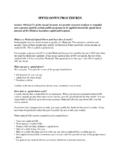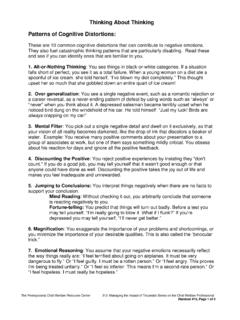Transcription of Supporting the Student with Down Syndrome in Your …
1 Supporting the Student with down Syndrome in Your Classroom Educator Manual Educator Manual Table of Contents 1 Introduction .. 1. a. About the down Syndrome Association of West Michigan .. 1. b. About down Syndrome .. 2. c. Myths & Truths About down Syndrome .. 3. d. People First Language .. 4. 2 Inclusion .. 6. What is Inclusion? .. 6. a. Conditions for Successful Inclusion .. 6. b. Practical Tips to Achieve Inclusion .. 7. 3 students with down Syndrome and General Education Classroom ..9. a. Health Conditions Associated with down Syndrome .. 9. b. Modifying the Curriculum for students with down Syndrome .. 12. c. Reading .. 15. d. Math .. 20. e. Communication .. 24. 4 Sensory Processing.
2 29. a. Sensory Processing .. 29. b. Characteristics of Sensory Processing Disorder (SPD) .. 30. c. SPD and the General Education Classroom .. 31. 5 Facilitating Friendships and Social Learning .. 33. a. Promoting Social Inclusion .. 33. b. Classroom Strategies .. 34. c. Buddy Programs.. 38. 6 Extracurricular Activities .. 40. a. Special Olympics .. 40. b. VIP Soccer .. 40. c. Challenger Little League .. 41. 7 Positive Behavior Supports .. 42. a. Causes of Inappropriate Behavior .. 42. b. Options for Behavior Management .. 43. 8 Appendices .. 45. a. Bibliography .. 45. b. Additional Reading .. 46. c. Websites .. 49. 9 Acknowledgements .. 50. 1 Introduction a. About the down Syndrome Association of West Michigan DSAWM is a 501(c)(3) nonprofit organization which is committed to spreading awareness and educating its membership and the general public about all issues associated with down Syndrome .
3 We are an affiliate of the National down Syndrome Society (NDSS) and National down Syndrome Congress (NDSC). Mission: To be a resource and advocacy organization promoting public awareness and Supporting the lifelong opportunities for individuals with down Syndrome and their families. DSAWM PRIORITY AREAS. Programming & Social Events We develop and/or promote programs and social events that enrich the lives of individuals with down Syndrome . We host periodic workshops and seminars and an annual one-half day conference. Our Let's Learn Series is for families of newborns and small infants. Boys Club provides recreational activities for young men age 8-18. THREADS (Together Empowering Adults with down Syndrome ) provides recreational, educational and friendship activities for youths age 14 and older.
4 Other activities include exercise, sign language and the MVP recreational program. We host monthly playgroups and parent coffees, bi-monthly educational meetings for the THREADS. parents and youth and yearly social events, such as our Summer Picnic and Holiday Party. Education We provide information, resources and support to parents and educators to ensure that individuals with down Syndrome receive a quality education to help prepare them for further education, employment and/or independent living. Family Support We provide social and emotional support to caregivers of individuals with down Syndrome . DSAWM volunteers make hospital and/or home visits, respond to telephone calls and/or e-mails and provide free new parent and prenatal diagnosis information/resource packets.
5 We provide financial assistance to families of individuals with down Syndrome to help members meet certain financial obligations in selected areas of interest and concern. Inclusion DSAWM promotes the inclusion of individuals with down Syndrome in our schools, communities, recreational facilities, and places of employment. Awareness We work to increase public awareness, acceptance, and understanding about the abilities of individuals with down Syndrome . October is down Syndrome Awareness Month. Each October, we host a Buddy Walk to celebrate the accomplishments of individuals with down Syndrome and foster acceptance. We make presentations to community groups, school-aged children, educators, and health care professionals.
6 Communication We keep DSAWM members and the community informed about DSAWM activities, programs, resources, and major events. Our monthly newsletter and website ( ) contain information including a list of current activities, contact information, links to resources, and archived copies of DSAWM newsletters. DSAWM Educator Manual Page 1. July 2010. Advocacy We advocate for all individuals with down Syndrome on medical, educational and legal issues. DSAWM can assist families in finding resources and researching topics relating to down Syndrome . b. About down Syndrome IS IT down 'S OR down Syndrome ? down Syndrome is named after Dr. John Langdon down , an English physician who first described the characteristic features of Trisomy 21 in 1866.
7 People now use the term down Syndrome as opposed to down 's Syndrome because Dr. down did not have down Syndrome and he did not own down Syndrome . WHAT IS down Syndrome ? For an unexplained reason in cell development, each cell results in 47 instead of the usual 46 chromosomes. In down Syndrome there is an additional number 21 chromosome, resulting in the medical diagnosis of Trisomy 21. This extra genetic material causes changes in the orderly development of the body and brain, as well as the physical characteristics and delayed physical, intellectual and language development associated with down Syndrome . MORE ALIKE THAN DIFFERENT. People with down Syndrome are more like their typically developing peers than they are different.
8 There is great diversity within the population in terms of personality, intelligence, appearance, humor, learning styles, compassion, compliance and attitude. Although persons with down Syndrome may share characteristics and similarities in appearance, children with down Syndrome will look more like their family members than they do one another. They will have a full range of emotions and attitudes, are creative and imaginative in play, and grow up to live independent lives with varying degrees of support and accommodations. Individuals with down Syndrome will establish friendships, pursue interests and be included in community activities. Children with down Syndrome benefit from the same care, attention, and inclusion in community life that help every Student grow.
9 As with all children, quality education in neighborhood schools, preschools, and at home is important to provide the opportunities needed to develop strong academic and social skills. FACTS ABOUT down Syndrome . down Syndrome is the most common chromosomal abnormality in humans. down Syndrome occurs in every 600-800 live births, and is not related to race, nationality, religion or socioeconomic status. While the age of the mother can be a factor, 80% of people with down Syndrome are born to parents under the age of 35, with the average age being 26. down Syndrome occurs in males and females evenly. Nothing that a parent did or did not do during the pregnancy causes a baby to have down Syndrome .
10 THE FUTURE FOR CHILDREN with down Syndrome . Individuals with down Syndrome have more opportunities than ever before. As young people with down Syndrome show what they can accomplish with the support of their families, friends and communities, and as they integrate mainstream programs, more and more doors open for others. We have seen a TV series starring a talented actor with down Syndrome . Two young men have authored a book, Count Us in: Growing up with down Syndrome , and have impressed audiences around the country at book signings and on talk shows. Honor Thy Son, a fast paced mystery by Lou Shaw, features two characters with down Syndrome who are faithfully portrayed as multidimensional young adults.



